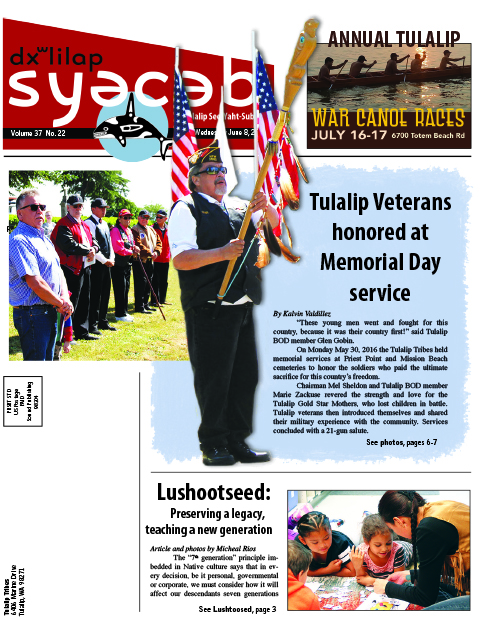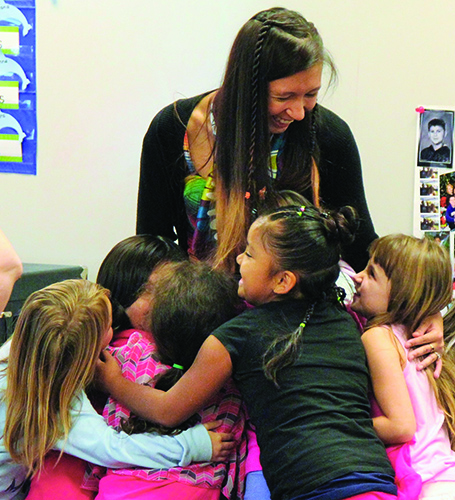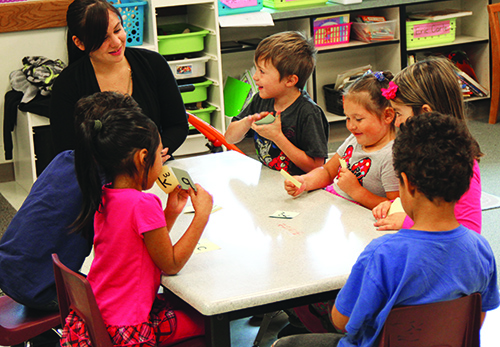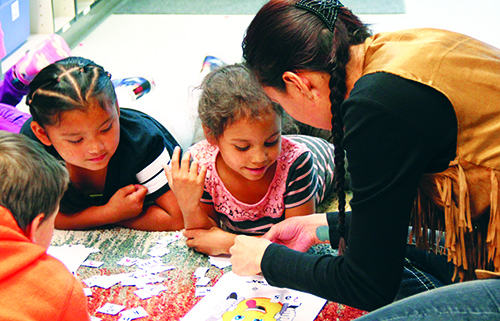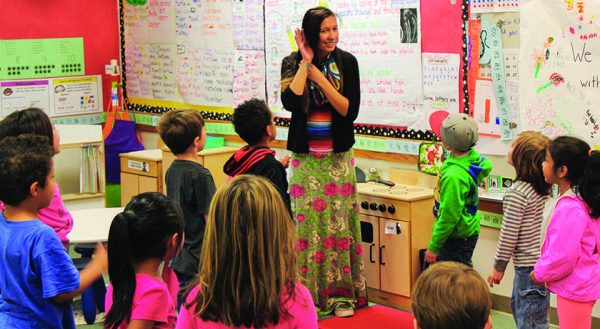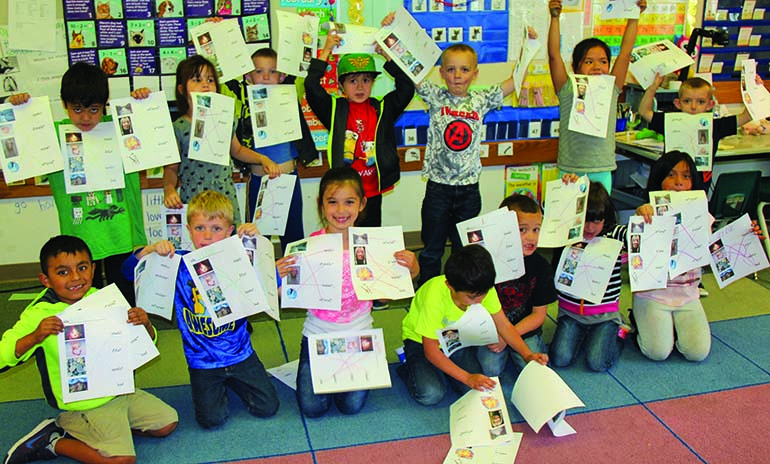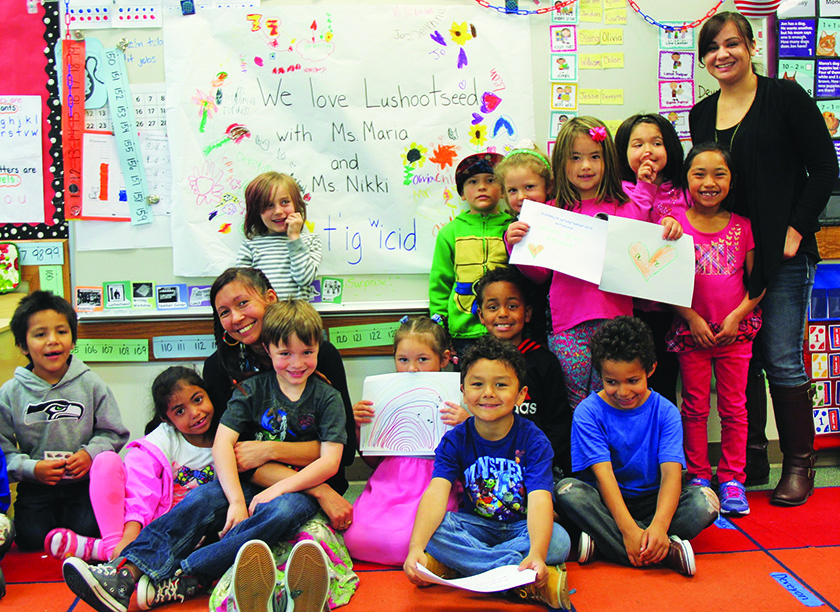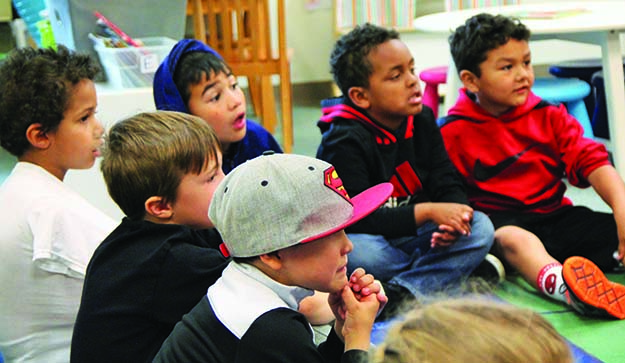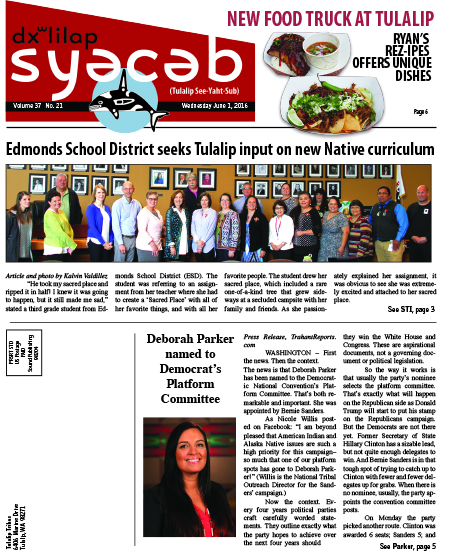Author: Kim Kalliber
June 8 2016 syəcəb
Tulalip Community Wellness Project Open House, June 7
Lushootseed: Preserving a legacy, teaching a new generation
by Micheal Rios, Tulalip News
The “7th generation” principle imbedded in Native culture says that in every decision, be it personal, governmental or corporate, we must consider how it will affect our descendants seven generations into the future. Long before environmentalists got us thinking about “carbon footprints” and “sustainability”, indigenous peoples lived in balance with the world around them. But then hundreds of years of colonization happened that nearly drove our population to extinction. Yet, still we remain.
Then came the decades and decades of federal policy aimed at forced assimilation for the remaining Native population who were confined to reservations. Policy after policy required children to be removed from their homes and communities, and enrolled in boarding schools where many were punished or beaten for speaking their Native languages. As a result, generations of Native people either never learned their language or lost their fluency in it. Thus, many links to traditional culture and knowledge were broken. Still we remain.
From the ashes of the colonial fire that ravished our people, we endured even though much was lost. The language of our region, Lushootseed, once spoken by thousands of Coast Salish people in Washington State clings to life by the small number of people dedicated to preserving it. Lushootseed’s territory extends from north of present-day Mount Vernon to south of Olympia.
Recent decades have seen a cultural resurgence in Puget Sound tribal communities, including carving, weaving, canoe making, and efforts to revitalize Lushootseed. New tribal museums and long houses have been constructed, and events such as the annual Canoe Journey involve hundreds of participants and thousands of spectators.
Today, on the Tulalip reservation, few elders remain who learned Lushootseed as a first language. In fact, Lushootseed Department Manager Michelle Balagot says there may be only 30-40 tribal members who can speak Lushootseed with some degree of conversational skill. She adds that although that number is incredibly low, the department is working hard to make sure that the language survives, and the next few years will be critical if the language is to be revitalized to the point that children become and remain fluent speakers.
The biggest advancement in preserving and revitalizing Lushootseed amongst Tulalip tribal members has been building an essential staff of Lushootseed teachers whose love for their language and culture can easily permeate through the young minds and spirits of our most precious resource, our children.
This past school year the Lushootseed Department had full access to teach our ancestral language to the kindergarten classes and one 1st grade class at Quil Ceda Tulalip Elementary School. It was the return back to a curriculum that had been paused in 2011 when the old Tulalip Elementary was closed.
“We have noticed an increase in student engagement when students have the chance to learn the language that connects them to their heritage. It certainly makes education more meaningful for our students,” says Cory Taylor, Quil Ceda Tulalip Elementary Principal. “While the Lushootseed program serves many Native students, it also benefits non-Natives, too. These students have the unique opportunity to develop skills to be culturally responsive. These skills will be beneficial throughout their lives. As students learn about other cultures and languages they are more likely to honor diversity and appreciate cultural awareness.”
Lushootseed language teachers Maria Martin and Nikki St. Onge, known respectfully as Miss Maria and Ms. Nikki to their students, were selected to initiate the language revival at the elementary. They taught three classes individually and one “immersion” class jointly, for a grand total of seven classes.
For Miss Maria and Ms. Nikki, it was an opportunity to perpetuate the many Lushootseed stories and phrases they learned as children, and build upon the legacy of those who came before them.
“My year teaching at Tulalip Quil Ceda was wonderful. I didn’t get a chance to learn Lushootseed in school after I left the Montessori, so being able to go back to the school I attended as a child and teach Lushootseed is amazing,” said Miss Maria. “This means we are growing as a language department and spreading our culture in places we weren’t able to before. Growing up I had a yearning to know and learn my culture, but it wasn’t offered in the schools. For the students that are enrolled in Tulalip or surrounding tribes, Lushootseed is their language, and my hope is they’ll be filled with the same kind of pride I have to know the words of our ancestors.”
“I really enjoyed teaching at Tulalip Quil Ceda. I am very grateful to have the opportunity to work with some of my students, since they were babies when I worked at the child care center in 2011. Then again at Montessori when I first started in the Lushootseed department in 2012, and now moving up with them to kindergarten,” marvels Ms. Nikki. “Not a lot of people get the opportunity to have this experience. It’s really rewarding to watch them grow and develop their own personalities and characteristics, and also teach them such an important part of our culture.
“Growing up at my Grandma Rachel’s house, I was exposed to Lushootseed a little bit with words or phrases like: x̌ʷubiləxʷ (be quiet), gʷəƛ̕əlad (stop it, behave), spuʔ (fart/blow wind), ʔaləxʷ k̓ʷid (what time is it?), hədʔiw (come in), č̓ut̕əp̓ (flea), sp̓əc̓ (feces), sqigʷəc (deer), yəx̌ʷəlaʔ (eagle), sqʷəbayʔ (dog), and pišpiš (cat). I was always interested in learning to speak Lushootseed, but it was never offered in school. When I saw the job advertisement within the Lushootseed Department I was excited. I have always wanted to learn Lushootseed and I love working with kids, so it was a perfect opportunity for me to grow as a person and to give back to the Tribe and community.”
Both Miss Maria and Ms. Nikki having taught Lushootseed at the Tulalip Montessori meant a strong familiarity and trust with their Tulalip students in their kindergarten classes at the elementary. All of their former students remembered them and were very excited to have them as Lushootseed teachers again. The excitement was shared by both teachers as they were able to create their own curriculum and teaching plans for students they knew very well. They knew what teaching methods would work and wouldn’t work with their students already.
Throughout the school year the students learned to play games, some of their favorites being təs-təs (matching game), ɬiʔɬdahəb (fishing), stab kʷi ʔəsx̌ʷil̕ (what’s missing?), xʷiʔ gʷadsx̌ək̓ʷud (don’t turn over), ʔuc̓əlalikʷ čəd (I win/bingo), go fish, and tic-tac-know. Students completed daily work sheets that taught them how to read and write in Lushootseed while reinforcing many of the vocabulary words they learned at Montessori and the new Early Learning Academy.
Some of their favorite songs they learned are: ʔi čəxʷ syaʔyaʔ (hello friend), kʷədačiʔb čəɬ syaʔyaʔ (ring around the rosy), huyʔ syaʔyaʔ (good bye friend), ʔə tə tib, ʔulub miʔman pišpišpiš (ten little kittens), šəqild st̕ilib (respect song), sʔacus sʔilalubid (head, shoulders), baqʷuʔ stubs (Frosty the Snowman), and waq̓waq̓ st̕ilib (frog song). The students were able to hear stories that were translated into Lushootseed and traditional stories such as “tsiʔəʔ bəšč̓ad” (Lady Louse), “tsi sxʷəyuq̓ʷ” (The Basket Lady), and “Clamming with Lizzie.” They learned to count up to 25 and were exposed to 30 and 40. They have also learned verbs, farm animals, woodland animals, body parts, clothing and so much more.
As the year progressed and the Lushootseed curriculum continued to evolve, so did the students. They developed such a good working knowledge with certain phrases and words that it became common place to hear the young students speaking Lushootseed even when Miss Maria and Ms. Nikki weren’t around.
“It’s difficult to put into words because it’s such an amazing experience to witness, this ownership of language and seeing themselves reflected in their school. It feels like this belongs to them between the drumming, the dancing and morning messages, then coming into class and starting our day with Lushootseed,” stated Mrs. Poyner, Kindergarten teacher and host to the immersion class taught by both Lushootseed teachers. “Having both Miss Maria and Ms. Nikki in the class at the same time I’ve really noticed the students are picking up the language much more quickly. They are using it in other parts of the day, like when we’re teaching math they’ll start counting in Lushootseed instead of English. When we’re doing letters of the alphabet and brainstorming words that start with a specific letter they’ll come up with Lushootseed words. When we are learning new stories with animals in it they’ll call the animals by their Lushootseed name. It’s so exciting to see them apply what they’ve learned into other pieces of their day.”
The teachers are even hearing numerous stories about their students using Lushootseed at home with their parents.
“I have heard stories of the students going home and singing the songs they learned in class and using their Lushootseed words,” says Miss Maria. “Running into parents of my students and hearing that they are reinforcing their Lushootseed at home makes my heart glow.”
Ms. Nikki echoes the sentiment, “Hearing from parents and teachers that students are reinforcing Lushootseed outside of their time spent with me in classroom is probably the most rewarding feeling. It means the students are not just learning a curriculum, they are learning a language, their language.”
Being able to demonstrate what you’ve learned is the basis of knowledge, and the young students using Lushootseed when the teachers aren’t around is proof positive the internal flame to connect with our culture and ancestors through language is being rekindled. It’s all part of an essential process to carry on our ancestors’ legacy by keeping the language alive. Because seven generations from now, we want Lushootseed to be the common language of all Tulalip people, like it was for our ancestors.
Contact Micheal Rios: trios@tulaliptribes-nsn.gov
Beef Jerky Outlet Celebrates National Beef Jerky Day

Percentage of Sales from Entire Weekend to Benefit Wounded Warrior Project®
KODAK, Tenn. (May 2016) – Beef Jerky Outlet locations across the U.S. are gearing up for National Beef Jerky Day, which takes place annually on June 12. This year, the Beef Jerky Outlet is celebrating the entire weekend leading up to National Beef Jerky Day with the $25 Extravaganza and a new charity partnership with Wounded Warrior Project® (WWP).
Five percent of the purchase price on all Beef Jerky Outlet transactions from June 10 through June 12, 2016, will be donated to WWP. The partnership is a natural fit because beef jerky is the number one favorite snack of the U.S. military. Jerky is easily transportable and a long-lasting food source, making it an ideal treat for our soldiers. In fact, NASA has sent beef jerky into space with our astronauts on multiple occasions.
“Our partners understand that wounded veterans need our compassion and support as they heal from the visible and invisible wounds of war,” said Gary Corless, chief development officer at WWP. “Thanks to the generosity of partners like Beef Jerky Outlet, we’re able to continue to provide the programs and services that meet injured service members, their families, and caregivers, wherever they are on their road to recovery. Whether its access to mental or physical health treatments, employment assistance programs, or continuing education opportunities, Wounded Warrior Project’s programs and services are offered free of charge, for a lifetime.”
In addition to partnering with WWP the Beef Jerky Outlet honors active and retired military personnel by offering them a 10 percent discount on any transaction, year round. The discount jumps to 50 percent for active and retired military franchisees purchasing their first Beef Jerky Outlet location.
“The Beef Jerky Outlet is a huge supporter of the U.S. military,” says Kathy Raines, Beef Jerky Outlet COO. “We’re proud to support our nations wounded veterans, by partnering with Wounded Warrior Project.”
The Beef Jerky Outlet specializes in more than 200 premium jerky varieties and sizes. Some popular specialty meats include alligator, elk, kangaroo and venison. They also offer a variety of exotic jerky flavors such as Moonshine and Cajun.
Jerky is lean, high in protein and nutritional value, and low in calories, carbohydrates, and fat (jerky is only 3 percent fat). It truly is the perfect treat for meat lovers of all ages and the popularity is rapidly growing.
- IRI, a Chicago based market research firm, reports sales of jerky jumped 46 percent from 2009- 2015, catapulting it to a $1.24 billion industry.
- In 2015 alone, Americans spent $2.8 billion on beef jerky
- Jerky is in the beef snack category — the fastest growing segment of the snack food industry (Convenience Store Decisions, Nov. 2012).
- Register to win free jerky for a year!
- $25 for three 4-ounce bags of jerky
- $25 for a Wild Game Box
- $25 for five bags of popcorn
- Free PETA (People Eating Tasty Animals) T-shirt to the first 10 customers each day
- Launch of the BJO Loyalty Cards Program (spend $25 five times and get $10 off)
About the Beef Jerky Outlet:
The Beef Jerky Outlet was founded in 2010 and is the country’s first national jerky franchise. There are currently 57 franchise locations, including 6 founder-owned stores. Over the next 18 months, this number will grow to more than 100 locations across the US. The Beef Jerky Outlet specializes in more than 200 jerky varieties including kangaroo, alligator, venison and elk. It is available in various sizes, as well as exotic flavors ranging from Moonshine to Cajun. Today, jerky is one of the fastest growing snacks in the snack food industry. This dried, smoked meat is the number one snack of the military, including NASA, which has been sending astronauts into space with jerky since 1996. Jerky is lean, high in protein, low in calories, is very low fat and has a very long shelf life. Millions seek out and enjoy this very nutritious snack every day. IRI, a Chicago based market research firm, reports that jerky sales have turned into a $1.24-billion industry. Across the country people are literally eating it up!
About Wounded Warrior Project®:
The mission of Wounded Warrior Project® (WWP) is to honor and empower Wounded Warriors. WWP’s purpose is to raise awareness and to enlist the public’s aid for the needs of injured service members, to help injured servicemen and women aid and assist each other, and to provide unique, direct programs and services to meet their needs. WWP is a national, nonpartisan organization headquartered in Jacksonville, Florida. To get involved and learn more, visit woundedwarriorproject.org.
NACTEP – Native American Career & Technical Education Program
by Jeanne Steffener, Tulalip Tribes Higher ED
Have you heard of the Native American Career & Technical Education Program (NACTEP)? More than likely you have seen advertising in the See Yaht Sub in the past for these classes at the Tulalip College Center. NACTEP was authorized to provide grants to Indian tribes, tribal organizations and Bureau funded schools to support career and technical education programs by the Federal Government. These programs are provided to help Native Americans prepare for high-skill, high-wage or high-demand occupations in established or emerging professions. The grant provides for the program’s teachers, tuition, books and stipends for students so they can effectively participate in their education.
Tulalip Tribes has partnered with Everett Community College (EvCC) and Edmonds Community College (EdCC) to provide the Native American Career and Technical Education Program (NACTEP) courses here at Tulalip. With EvCC the focus has been on the Tribal Business Technology Certificate Program. These classes may be applied to a future degree. The goal of the courses and program is to provide students with the skills and knowledge necessary to gain employment as office support and customer service front line staff. There is a current need within the Tulalip Tribes for these skills.
Edmonds Community College’s focus has primarily been on the Leadership-Management courses. The Leadership Certificate of Completion can be earned by completing a series of courses on Supervision Basics, Presentation Skills, Leadership, Effective Teams and Coaching & Mentoring.
The success rates for NACTEP students is documented and demonstrates that Native American students are progressing through these skill and knowledge building programs nationwide. These students are better prepared to pursue further education or enter into high-skilled or high-wage employment. Courses are offered to all Tulalip members, employees & community members.
This Summer 2016 quarter is beginning July 5th. Courses offered this summer are Business Communications, Introduction to Microsoft Word, Job Search/Professional Development, Beginning Keyboarding, Keyboarding – Speed & Accuracy, Records Management, Service Essentials for Business, Computer Literacy. We are having two (2) Drop-In Sessions on May 31 (2-4 pm) & June 16 (4-6 pm) at the Administration Building in room 263. The complete AD will be in a couple of upcoming issues in the See Yaht Sub. Please look for them.
If you are interested in becoming part of this success story and opening up your opportunities, just pick up your phone and dial 360-716-4888 to contact the Higher Education Department for more information or email us at highered@tulaliptribes-nsn.gov.
Public Health Alert: Hand Foot and Mouth Disease (HFMD) in Tulalip
Thank you for your attention and for caring for your community.
June 1 2016 syəcəb
Tribal Court Warrant Quash Fridays
by Wendy Church, Tribal Court Director
If you have a warrant for your arrest on the Tulalip Reservation, you may be able to quash your warrant.
Warrants are issued because you failed to appear at your hearing, or there was a criminal complaint filed against you, also if you have failed to comply with a court order, such as having a probation violation or a missed urinalysis. You may be able to quash old warrants and get a new hearing date.
For first time offenders (sometimes second time offenders), your warrant quash will cost you nothing. If you are a repeat offender, the judge may levy a fee for you to quash your warrant, anywhere from $25, $50 or $75 dollars. The police, prosecution, and probation are then notified that you came to the court to quash your warrant. It is advised to please keep your warrant quash paperwork on you for at least one week.
The Tribal Court encourages you to come in to quash your warrant. It shows you are taking care of business and makes a good impression on the judge.
Warrant quashes are held on Fridays from 10:00 a.m. to 11:00 a.m.—it is advised you show up no later than 10:45 a.m. to quash your warrant.
If you have questions regarding warrant quashes, you can call the Tribal Court
at 360 / 716-4773.
Deborah Parker named to Democrat’s Platform Committee
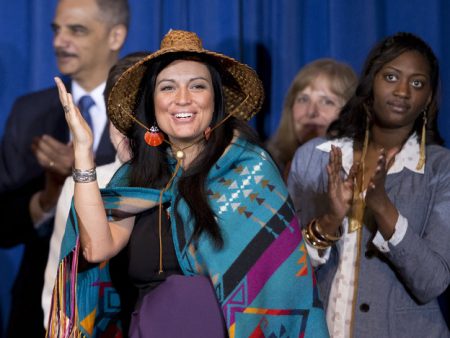
Press Release, TrahantReports.com
WASHINGTON – First the news. Then the context.
The news is that Deborah Parker has been named to the Democratic National Convention’s Platform Committee. That’s both remarkable and important. She was appointed by Bernie Sanders.
As Nicole Willis posted on Facebook: “I am beyond pleased that American Indian and Alaska Native issues are such a high priority for this campaign– so much that one of our platform spots has gone to Deborah Parker!” (Willis is the National Tribal Outreach Director for the Sanders’ campaign.)
Now the context. Every four years political parties craft carefully worded statements. They outline exactly what the party hopes to achieve over the next four years should they win the White House and Congress. These are aspirational documents, not a governing document or political legislation.
So the way it works is that usually the party’s nominee selects the platform committee. That’s exactly what will happen on the Republican side as Donald Trump will start to put his stamp on the Republicans campaign. But the Democrats are not there yet. Former Secretary of State Hillary Clinton has a sizable lead, but not quite enough delegates to win. And Bernie Sanders is in that tough spot of trying to catch up to Clinton with fewer and fewer delegates up for grabs. When there is no nominee, usually, the party appoints the convention committee posts.
On Monday the party picked another route. Clinton was awarded 6 seats; Sanders 5; and the remaining 4 will be appointed by the party itself. Politico call this a “concession” to Sanders because his supporters will be able to influence the party to be more progressive on a range of issues, such as a higher minimum wage.
Parker, a former Vice-Chairman of the Tulalip Tribes in Washington, was an early supporter of Sanders. Parker has much to offer any platform committee. First, she understands and can communicate the relationship between tribes and the federal government and what might be possible in terms of improvement. Second, Parker was a critical voice in the enactment of the Violence Against Women Act. She adds expertise and credibility.
Four years ago, the Democratic Party Platform included this section on Tribal Sovereignty:
American Indian and Alaska Native tribes are sovereign self-governing communities, with a unique government-to-government relationship with the United States. President Obama and Democrats in Congress, working with tribes, have taken unprecedented steps to resolve long-standing conflicts, finally coming to a resolution on litigation—some dating back nearly 100 years—related to management of Indian trust resources, administration of loan programs, and water rights.
President Obama worked with Democrats to pass the HEARTH Act to promote greater tribal self- determination and create jobs in Indian Country. The Affordable Care Act permanently reauthorized the Indian Health Care Improvement Act to improve care for Native Americans. Democrats enacted the Tribal Law and Order Act, support expansion of the Violence Against Women Act to include greater protection for women on tribal lands, and oppose versions of the Violence Against Women Act that do not include these critical provisions. We will continue to honor our treaty and trust obligations and respect cultural rights, including greater support for American Indian and Alaska Native languages. Democrats support maximizing tribal self-governance, including efforts for self-determination and sovereignty of Native Hawaiians.
In addition to Parker, other members of the Democratic Platform Committee: Bernie Sanders’ appointments are Dr. Cornell West, Rep. Keith Ellison (D-Minnesota), Bill McKibben (Author, expert on climate change), and James Zogby (Arab American Institute). Hillary Clinton’s appointments are Ambassador Wendy Sherman, Neera Tanden (Center for American Progress), Rep. Alicia Reece (D-Ohio State), Carol Browner (Former EPA head), Rep. Luis Gutierrez (D-Illinois), and Paul Booth (union leader).
Maryland Rep. Elijah Cummings, who has endorsed Clinton, will head the committee. The DNC also named Rep. Barbara Lee, D-California; Former Rep. Howard Berman, and a former CEO, Bonnie Schaefer.

